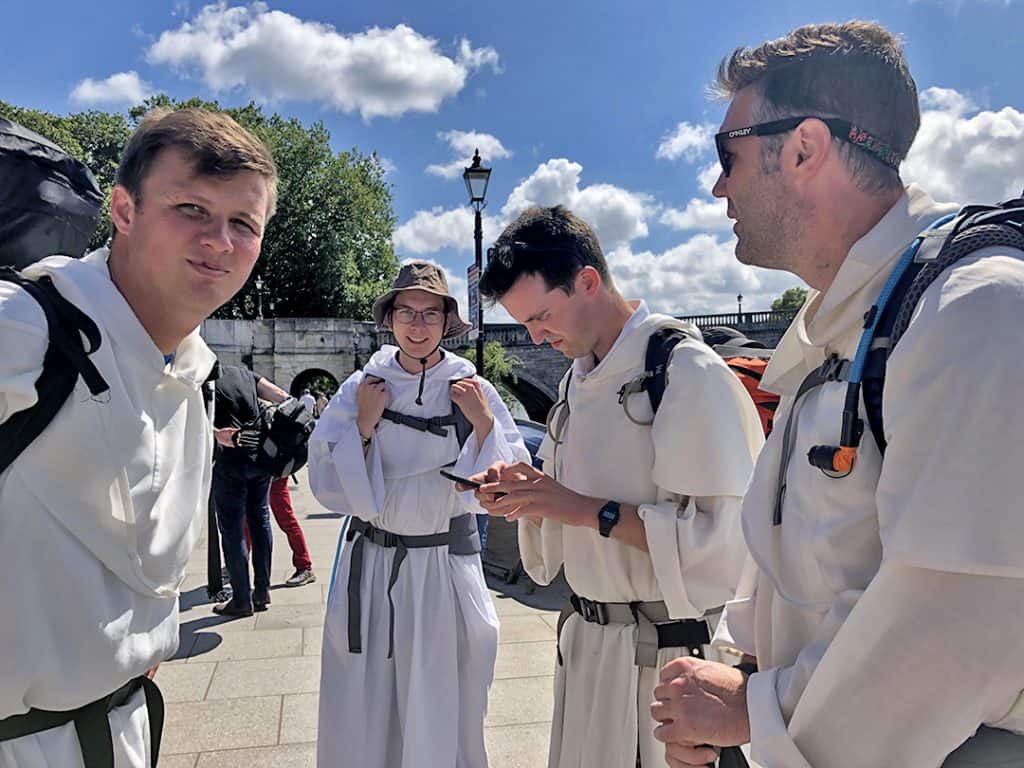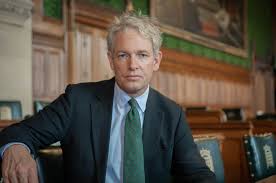This Sunday, four Dominican friars will complete a 230-mile pilgrimage on foot from Kent to Oxford via Canterbury to mark the 800th anniversary of the arrival of the Dominican Order in England.
The journey, mirroring that of the friars who arrived here in 1221, is part of a series of events celebrating the anniversary. But the pilgrimage is the most arduous and also the most spontaneous of the events, with others joining the friars along the way to participate in at least part of the pilgrimage. It also highlights the growing popularity of pilgrimage today, attracting not only active Christians but others who find pilgrimages spiritually appealing.
The journey combines both the traditional and the modern: the Dominicans, also members of the Order of Preachers, will be stopping along the way to attend church services, pray the Catholic devotion of the rosary, and preach, while also uploading videos of their trip on a pilgrimage website. They have also been praying for people who have emailed them requests during the trip.
According to Fr Samuel Burke, one of the four friars walking from Ramsgate to Oxford, the pilgrimage was an ideal way to follow in the footsteps of the first Dominicans to arrive in England. “It means we are going back to our roots — to our itinerancy, our poverty and appreciating God’s grandeur along the way.”
The friars are dressed in their striking white habits. “Nobody is going to notice us in ordinary clothes,” said Fr Samuel. “This is a means of witness. Some people come up to us and ask who we are and what we are doing. They are often very interested.”
Some passers-by imagine the friars are wearing fancy dress. “Are you on a stag do?” is a question asked more than once, while others have stopped to tell the Dominicans of difficulties in their lives. On Tuesday, as the friars walked by the Thames from Chiswick in west London to Hampton Court, a dozen people joined the trek. They included volunteer members of the Order of Malta, a friar’s parents, young people thinking about vocations as nuns and monks, and churchgoers who heard about the walk. On other days Christians of other denominations — and atheists — have joined, too.
“We don’t force our faith on anyone,” said another pilgrim friar, Fr Toby Lees. “If people ask about it while we are walking, and so invite us to talk about it, we will.”
According to Fr Martin Generi, provincial of the order, the first Dominicans in England travelled from the heart of the order, from St Dominic in Bologna, “all the way up to Britain to begin a new mission in a land that had just recently seen the battles between King John and the barons.
“I wonder what those first men felt as they approached our shores. Trepidation? Eager anticipation? Certainly, though, their warm reception in England is undeniable.”
The current pilgrims have also enjoyed a warm reception, not only from Roman Catholic churches but also Anglican churches along the route, singing vespers in St Peter and St Paul’s, Charing, and Canterbury Cathedral. Priests and families along the way have put them up for the night.
Day 7 of the #OP800pilgrimage started early with a 6am Mass at St Anselm’s, then we set off (in the rain…), stopping with our Franciscan brothers in Erith for lauds, and on via Lesnes Abbey towards Greenwich, before walking underneath the river and round to Wapping for vespers. pic.twitter.com/503X8xmJOb
— English Dominicans (@English_OP) August 7, 2021
During the Middle Ages, England had 57 Dominican houses, more than any other European country, with their occupants known as the Black Friars because of the cloak worn over their white habits.
Parliament occasionally met within the walls of Dominican priories and the divorce trial of Catherine of Aragon met in Blackfriars, London, in 1529 — a trial that led directly, via Henry VIII’s marriage to Anne Boleyn, to England’s break with Rome and the dissolution of the monasteries.
All Dominican houses were destroyed during the Reformation. The English province fled to Belgium and it was not until 1854 that a new house was opened here, in Gloucestershire. The Dominicans returned to Oxford, where they had run a friary, in 1921.
This month’s 15-day walk takes in many places associated with church history in England, including Ramsgate, where St Augustine of Canterbury landed in 597 to convert Saxons to Christianity; Canterbury Cathedral, where Thomas Becket was murdered and where the first Dominicans to land here made their first recorded stop, to visit Becket’s shrine; the village of Charing, where St Richard of Chichester was rector in 1243, and Aylesford, home of the Carmelites, which was abandoned at the Reformation, with the Friars returning in 1949.
The journey has also included two days in London, visiting Charterhouse, from where Cistercians were taken and executed during the Reformation, the shrine of Edward the Confessor at Westminster Abbey, and Hampton Court, once home to Cardinal Thomas Wolsey. Sites where Dominican convents and friaries once stood, including Blackfriars in London, have been passed as the friars continues along the Thames to Oxford.
This is not the first time that members of a religious order have walked a commemorative pilgrimage: in 2017 monks from the Benedictine monastery of Pluscarden, near Elgin, Scotland, spent 13 weeks walking 1,400 miles from Val des Choues in Burgundy, France, back to Pluscarden to mark the journey made more than 800 years earlier when the monks travelled to Scotland to found the monastery. The 2017 group brought stones from their ancient home to form the foundations of a restoration project.
Guy Hayward, co-founder of the British Pilgrimage Trust, said that both the Benedictines and the Dominicans were finding a different way to express returning home. “You could just drive to Oxford, but placing foot in front of foot in front of foot is very different,” he said.
“Not only do you carry out the journey but you have a sense of purpose, a ritual and a coherence about what you are doing.” Similar experiences, he said, were attracting others to pilgrimages too.
Andy Bull, author of Pilgrim Pathways: 1-2 day walks on Britain’s Ancient Sacred Way, said he had found a new interest in pilgrimages in Britain during the Covid lockdown.
“There were people who didn’t normally go walking but discovered a new interest in it during lockdown when it was one of the few things they could do and wanted a purpose for walking,” he said. “And there were people who normally go abroad for pilgrimages, such as to Spain for the Camino [to Santiago de Compostela] who could not go and wanted to discover routes in England instead”.
While the Pilgrimage Trust offers many rediscovered pilgrimage routes across the UK on its website, Bull is researching another one: London to Walsingham, site of a vision of the Virgin Mary and highly favoured by Henry VIII until his break with Rome.
The shrine has become popular again with Roman Catholics and Anglicans in the past 100 years but the pilgrimage route is now being mapped again by Bull and the Confraternity of St James, a pilgrim organisation that promotes the Camino. They have researched footpaths that come close to following the old Walsingham route but avoid major A roads and motorways, and the route links London and Walsingham via Ware, Saffron Walden, Bury St Edmunds and Norwich.


















